SUPPORTING CITY KNOW-HOW
Human and planetary health are influenced by city lifestyles, city leadership, and city development. For both, worrying trends have led to increasing concern – and it is imperative that these become core foci for urban policy. This will require concerted action and the journal Cities & Health is dedicated to supporting the flow of knowledge, in all directions, to help make this happen. We wish to foster communication between researchers, practitioners, policy-makers, communities, and decision-makers in cities. This is the purpose of the City Know-how section of the journal. We, and our knowledge partners (the International Society for Urban Health and Salus.Global), invite you to join these conversations with the authors and communities directly, and also to consider publishing in Cities & Health to influence urban policy.
This special issue of Cities & Health examines planning for people and health in urban settlements from an environmental psychology perspective. It comprises a leading editorial with 20 other articles. These provide insight into spatial planning, design and governance for urban health and health equity.
The issue’s shorter articles include a ‘city short’ a commentary piece, and seven book reviews, all with relevance to the psychological sciences.
In addition, eleven papers from researchers reporting on completed studies or conceptual enquires are included. Each of these research studies and their findings are distilled here as accessible ‘City Know-how’ briefings to support city and town-based action.
We invite you to scan this wealth of content. There are many shared urban problems, and we think there are solutions already found by some, waiting to be discovered by others.
As a journal, we welcome contributions from all readers. This may be conjecture, commentary and debate arising from the papers or from your own case studies. Let’s make human settlements healthier, more equitable for communities, and healthier for the planet.
Urban walks to benefit psychophysiological wellbeing; during COVID-19
Urban green walking. Photo by Brian Kusiak.

Assessing the impact of walking in different urban spaces during the pandemic highlights the positive effects of high-quality green spaces for mental health.
For the attention of: Environmental psychologist, urban designers and planners, urban geographers, landscape architects, citizen scientists, community scientists.
The problem: The onset of COVID-19 highlighted the need for outdoor spaces that both promote physical activity and positively influence psychological and physical health and wellbeing outcomes. Residents of Richmond, Virginia, USA, fell short of the Centres for Disease Control and Prevention (CDC) physical activity guidelines prior to the pandemic. This suggests there is a public health requirement to understanding how urban spaces can be utilised and promoted to fulfil this need.
What we did and why: We compared psychophysiological outcomes in participants walking in two urban conditions. During one session, participants walked in an ‘urban gray’ setting: a built route with increased pedestrian and vehicular traffic. The alternate session was an ‘urban green’ setting, made up of tree lined residential streets and a pocket park. Measures included pre/post walk assessments of mood, thermal comfort and sensation and working memory and real time measurements of heart rate variability, air pollution and temperature.
What our study adds: Our research adds an understanding of the psychophysiological benefits of urban (green) walks and how this has implications for public health and how we engage with our local environment. We explore the environmental characteristics that may influence these outcomes, such as particulate matter and thermal conditions.
Implications for city policy and practice: The evidence builds on a narrative that demonstrates the health benefits of urban walks. However, it adds additional context such as where these walks could take place. Further public health implications are discussed surrounding both subjective and objective health outcomes.
Further information and projects: Center for Design + Health at the University of Virginia. Their stated mission is to understand how the design of our built environments can address multiple urban challenges so that our cities and the places we work and live are healthier and more nourishing for everyone. Their goal being to foster and apply research to design solutions that allow us to be fitter, happier, more productive, age better, live longer and help us all live together in a positive and meaningful way.
Full research article: The impact of urban walking on psychophysiological wellbeing by C. Neale, J. Hoffman, D. Jefferson, J. Gohlke, M. Boukhechba, A. Mondschein, S. Wang & J. Roe.
Inequity in loneliness and the role of built environment
Can lonely people benefit from walkable neighbourhoods? Queen St Mall, Brisbane City, Australia. Image: ©Google Streetview 2022.
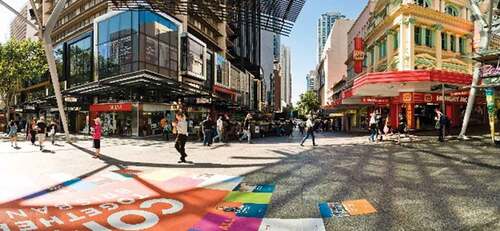
For the attention of: General public health and ministers concerned with loneliness internationally including policy makers, urban planners, developers and housing estate designers.
The problem: Although inequity in loneliness has been reported in previous research, little is known about environmental factors. There is a gap in our understanding as few studies have explored the environmental influences of loneliness.
What we did and why: A higher proportion of lonely mid to older adults live in disadvantaged neighbourhoods. The understanding of modifiable environmental factors contributing to the relationship between neighbourhood disadvantage and loneliness is limited. Studies have suggested that having well-connected walkable environments with a mix of land uses, can afford physical and mental health benefits. This is one of the first studies to explore environmental influences of loneliness. We examined whether walkable environments contribute to the relationship between disadvantaged neighbourhoods and loneliness.
What our study adds: Our study shows that higher residential density, partly contributed to the observed differences in loneliness across neighbourhood disadvantage, even with adjustment for individual level socio-economic factors.
Implications for city policy and practice: Our results emphasise the importance of residential density as an influence on loneliness, especially in disadvantaged neighbourhoods. We point to the importance of policy, planning and design in terms of reducing levels of loneliness among residence of socio-economically disadvantaged neighbourhoods.
Further information about loneliness available at these websites: Australian Psychological Society Loneliness study, Loneliness in Australia; Statista Research Department blog, How often do you feel lonely worldwide?; Campaign to End Loneliness website, Campaign to End Loneliness; The Loneliness Lab website, Loneliness lab; Ending Loneliness Together website, Ending Loneliness Together in Australia
Full research article: Contribution of the built environment to inequity in loneliness by neighbourhood disadvantage in Australia by Tara Jamalishahni (@trjmlshn), Gavin Turrell, Karen Villanueva, Sarah Foster and Melanie Davern.
How does being in the presence of skyscrapers make you feel?
Example with low-rise building, St. Helen’s Bishopgate Church, and high-rise building in the background, London, England.
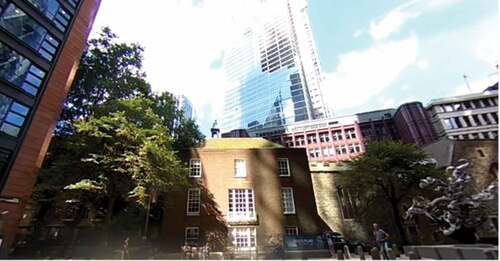
As cities become more densely populated, we are increasingly building upward. What are the psychological implications of this shifting urban landscape?
For the attention of: City planners, urban designers, architects, urban policy makers, city mayors
The problem: Cities are densifying and are increasingly building skyscrapers. It is suggested that being in the presence of these massive buildings can have negative effects on psychological state. Considering the cities of the future could be dominated by skyscrapers, to the extent that they could be all we see, we need to better understand the psychological impacts to help inform urban design practices.
What we did and why: We took people to a location in Central London that had access to a low-rise and high-rise building. To understand the psychological impacts of building height, we exposed people to both and measured their emotional responses using wearable technology and a psychological questionnaire. We also took 360-degree video of the locations and repeated the study in virtual reality, which allowed us to have more experimental control and increased sample size.
What our study adds: Our findings suggest that city environments populated with high-rise buildings can have negative emotional impacts on urban dwellers. Furthermore, this study demonstrates that 360-degree video viewed in virtual reality headset can elicit similar responses to those found in the real world, suggesting that this methodology can be used to further explore the psychological impacts of urban design.
Implications for city policy and practice: Our study suggests that cities should pay more attention to how many and where high-rise buildings are built. Practical implications such as space between buildings, or their proximity to public spaces such as parks should be considered.
Links to other resources and support:
London’s Tall Building Strategy
Full research article: Exposure to high-rise buildings negatively influences affect: evidence from real world and 360-degree video by Robin Mazumder (@robinmazumder), Hugo J. Spiers (@hugospiers) and Colin G. Ellard (@whereaminow).
Recreating a therapeutic blue urban space: the restoration of the Triton Fountain in Valletta, Malta
Triton Fountain in Valletta, Malta. Photo by Bernadine Satariano.
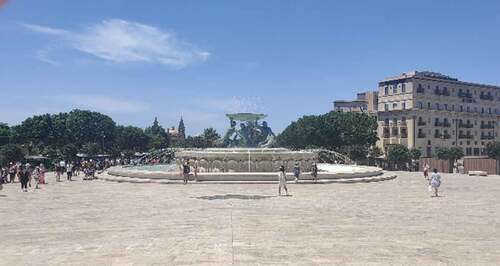
Looking at city water features as therapeutic blue urban spaces. Based on the architectural redesign of a water fountain in Valletta, Malta. We studied its restoration and conservation to understand its potential influence as a therapeutic blue urban space in the public realm.
For the attention of: Urban planners and architects, policy-makers and local government, public health practitioners, and the public.
The problem: The presence of water features in urban environments are important for human health and wellbeing and arguably have a greater role in densely built-up environments. The lack of maintenance of fountains and public squares may cause feelings of stress and anxiety to citizens. There is currently little research that explores the connection between conservation and maintenance of water features in urban places and the relationship with people’s health and wellbeing.
What we did and why: This study draws on qualitative in-depth interviews with regards to a restoration project of a water feature which is located at the entrance of the city in Valletta, the capital city of Malta. The research explores the role of the Triton Fountain and square before and after its restoration and conservation to understand its potential influence as a therapeutic blue urban space.
What our study adds: Citizens find nature-like architecture of urban water features supportive for their wellbeing through:
Interaction that enables a connection to nature and place,
Managing potential stress and anxiety by providing a place to cope with an urban heat island environment, chaos, danger, noise, and pollution,
Aesthetic attributes and recalling memories of place before restoration which can help provide a therapeutic environment.
Implications for city policy and practice: The findings highlight the potential of urban water features to provide a therapeutic environment for citizens. Planners and urban developers could consider the investment in restoration of architectural design of urban water features as an intervention to support citizens health and wellbeing as part of planned therapeutic blue urban spaces.
Full research article: Recreating a therapeutic blue urban space through the architectural restoration of the Triton Fountain in Valletta, Malta by Bernadine Satariano.
Open spaces and wellbeing: outdoor environments to promote health
Neighbourhood park in high density residential area.
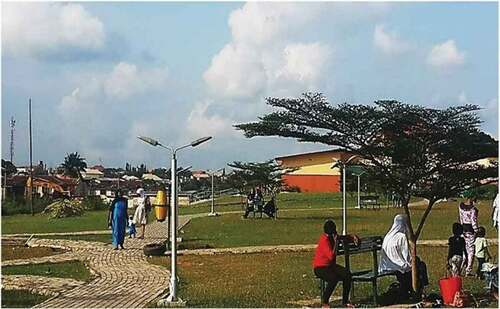
Open spaces are known to improve the health and well-being, however there are few studies from developing countries. This Nigerian study examines socio-economic characteristics of residents, attributes and uses of neighbourhood open spaces and self-rated health.
For the attention of: Landscape architects, urban designers and planners, public health practitioners and policy makers.
The problem: There is insufficient contextual empirical evidence on the association between open spaces, physical activity, and health in the Global South, particularly in Nigeria. Therefore, it is unknown how open spaces could support behaviours for active living for residents in the region.
What we did and why: We examined the influence of urban open spaces on physical activities in a Southwestern Nigerian city. Our study looked at the relationships among socio-economic characteristics of residents, the attributes and uses of neighbourhood open spaces and self-rated health of residents. We used a cross-sectional survey with 1659 participants in Osogbo, Osun State, Nigeria. Our primary data was collected through questionnaires and direct observations on attributes of open spaces. Secondary data such as maps were also included in data analysis.
What our study adds: We found that most people in the city rarely use open spaces for vigorous or moderate physical activities, instead they prefer to do sedentary activities. However, our results support a socio-ecological theoretical framework that adds insight. In particular, our results showed that:
Age, household size, income and education level significantly influenced residents’ assessment of open space quality,
Physical, stress reduction and social cohesion activities influences the relationship between open spaces and health indirectly,
Open spaces influence residents’ health indirectly through activities performed.
Implications for city policy and practice: Following our study, we suggests policy and practice should consider:
Urban design interventions that include varied facilities to attract all user groups,
Community based events that encourage residents to get more active should be organised by government and non-government bodies,
Unexploited natural sites in the city should be developed to provide more avenues for healthy lifestyles,
Features that can improve the quality of open spaces and attract all user groups should be provided.
Full research article: Open spaces and wellbeing: the impact of outdoor environments in promoting health by A. O. Ajayi and O. O. Amole.
Place qualities affect people’s sense of place and subjective well-being
A street sitting out area in Sham Shui Po. Photo by Mee Kam Ng.
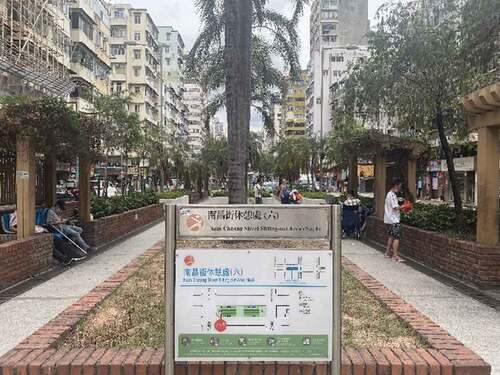
Place qualities affect people’s place identity, attachment, and behaviour, as well as their emotional, psychological, and social well-being. This is core to healthy cities, urban futures and public health.
For the attention of: Urban planners and designers, students of the built environment, property developers and urbanists.
The problem: There is limited awareness of the impact of spatial arrangements of the built environment on peoples’ sense of place which can influence their subjective well-being (emotional, psychological, and social). We explore the relationships between the built environment, place, and subjective well-being to understand implications for urban planning and design. People who assess place qualities positively tend to have a stronger sense of place. Sense of place is a good predictor of people’s multi-faceted subjective well-being.
What we did and why: We chose two typical high-density urban districts in Hong Kong with different place qualities (one old urban area and one new town, each housing about 3.5 million population) and examined how residents in the two districts evaluated their sense of place and subjective well-being. We also collected their socio-economic and demographic details for analyses. We wanted to examine how place qualities in the two different districts affect people’s sense of place and their subjective well-being.
What our study adds: Place qualities are associated with people’s sense of place.
Community and public spaces are prominent predictors of a stronger sense of place
People who have a stronger behavioural (committed) sense of place have better emotional, psychological, and social well-being
Sense of place is a good predictor of people’s subjective well-being
The study provides two self-validated place qualities and sense of place scales, the latter attempts to measure people’s cognitive, affective, and behavioural sense of place.
Implications for city policy and practice: Urban policy needs to recognise that place qualities matter and that people need to be involved in the place-making processes, especially in planning and designing community and public spaces;
Collaborative place-making boosts people’s sense of place and their subjective well-being,
People who have a stronger sense of place are usually emotionally happier individuals,
Places with high use values and promote mutuality help nurture people’s sense of place,
People who are committed to a place have stronger psychological and social well-being.
For further information: Institute of Future Cities at the Chinese University of Hong Kong: Established in 2013, a hub for researchers in diverse fields to collaborate in examining a wide range of past and present urban issues and to collectively envision, research and advocate innovative approaches to shape future cities to be environmentally friendly, economically prosperous and socially just.
Full research article: Place qualities, sense of place and subjective well-being: a study of two typical urban neighbourhoods in Hong Kong by Mee Kam Ng, Tsz Chun Yeung, Mei-Po Kwan, Hendrik Tieben, Tony Yuk Tai Lau, Jiageng Zhu and Ying Xu.
Creating green spaces in Singapore that improve health and conviviality through ‘nature placemaking’
The nature placemaking activities at the Ground-Up Initiative NGO.
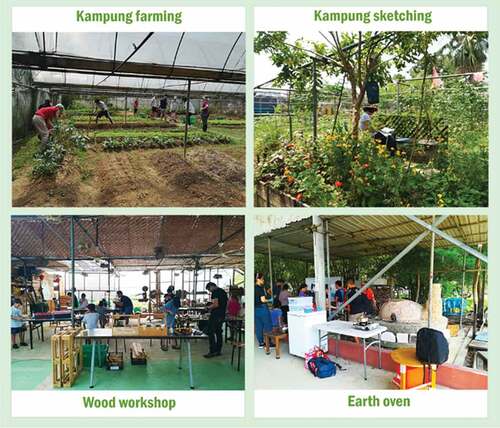
The involvement of citizens in nature placemaking processes can have a positive impact in the psychological health and wellbeing. The connection with the natural environment and community is grounded in five core principles recognized as the 5Gs: Gracious, Green, Giving, Grounded and Grateful, as conveyed through the activities.
For the attention of: Urban farming organisations, Urban designers and planner, Landscape architect, Urban health practitioners and placemaking NGOs.
The problem: Singapore faces the challenge to adapt to a new urban lifestyle after the declaration in 2021 of the ‘Green Plan’ agenda on sustainable development. The plan includes strategies to increase access to urban greenery and biodiversity in the city. Nevertheless, there have been reported cases of low citizen tolerance towards the newly introduced biodiversity. Additionally, unsustainable behaviours of citizens could be a threat to the new natural ecosystems.
What we did and why: Our research investigated a pro-environmental organisation in Singapore that has implemented participatory programs with nature and aims to improve the health and wellbeing of people and their connection to nature for over a decade. We conducted focus groups, discussions and surveys to establish the benefits of engaging in these programs and to understand to what extent the facilitators of the process have an impact in the way people shape their connection with nature, developing pro-environmental behaviours.
What our study adds: Our work supports a new approach to placemaking with nature and the therapeutic value of non-curated natural landscapes. It shows the:
Improvement of health and wellbeing in heavily urbanised cities through the implementation of programs that enhance the connection with the natural environment,
Importance of the facilitators of placemaking in the long term to create an improved psychological wellbeing and sense of community.
Implications for city policy and practice: Urban Policies should consider integrating nature placemaking strategies to enhance the health and wellbeing of citizens and their conviviality. Experienced nature placemaking facilitators and their spaces could become a learning hub for young citizens that have not yet experienced a raw natural environment in Singapore. Importantly, this could increase pro-environmental behaviours and tolerance towards natural biodiversity.
For further information see the Urban Land Institute/Health Leaders Network at NeuroLandscape: NeuroLandscape is a non-profit research group/NGO that brings together landscape architecture, neuroscience and computer science to advance the knowledge on the relationship between human health and the environment in urban areas. Their aim is to uncover the complex mechanisms of these phenomena and share them with an international audience of academics, designers, decision makers and urban communities.
Full research article: Participatory approaches to enact meaningful interconnectedness with the natural environment: a case study in Singapore by Diana M. Benjumea, Yohei Kato and Keng Hua Chong.
Residents reports of construction defects in new apartments are associated with poorer mental wellbeing
Typical example of new apartment buildings studied in Australia. Photo from the authors.
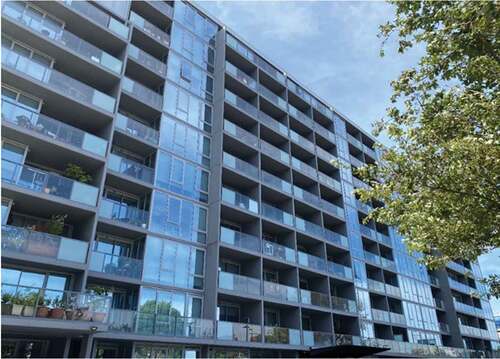
A study of apartment residents identified an association between construction defects and mental health. For every additional problem, wellbeing decreased and psychological distress increased.
For the attention of: Local Building Codes Boards and house-build standards agencies; building construction and maintenance industry; owners corporation; apartment residents; community public practitioners.
The problem: Studies have addressed housing problems more broadly rather than on apartments where the collective ownership structure can make the process of rectifying defects more challenging. There are widespread reports of construction defects in new apartment buildings in Australia and internationally. While anecdotal evidence exists about the stress that these defects cause, the mental health impacts of these specific building problems, such as cracking, internal water leaks, and faulty plumbing and electrical work, have not been examined.
What we did and why: Apartment buildings built between 2006 and 2016 were randomly selected from three Australia cities: Sydney, Melbourne and Perth. Buildings were sampled from areas of low, mid and relatively high disadvantage. Residents were invited to complete a survey that included questions on construction problems that impacted their apartment and their mental health. Associations between the count of defects and mental health was examined, using measures of mental wellbeing and risk of psychological distress
What our study adds: Our study highlights a hidden consequence of the rapid growth in apartment buildings in Australia. For every additional defect reported, mental wellbeing reduced, and the risk of psychological distress increased. The association between defects and mental health may be aggravated by the bureaucratic obstacles faced by owner-occupiers and rental tenants when negotiating defect rectification work. Policy interventions are needed to minimise the incidence and severity of defects, while streamlining defect rectification processes.
Implications for city policy and practice: Residents in apartments affected by defects must cope with the day-to-day consequences of them, combined with the potential stresses of seeking and negotiating remedial work. This could be aggravated by the communal ownership and management processes of multi-owned apartment buildings, which will directly impact owner-occupiers who are party to these often-protracted negotiations, but also impact the timeliness of repairs for rental tenants in these buildings.
For further information: The Centre for Urban Research. This is a hub for interdisciplinary urban research. Through its research, the Centre is responds to the globally important need to shape cities to be more environmentally, socially and economically sustainable.
Full research article: Cracking up? Associations between building defects and mental health in new Australian apartment buildings by Sarah Foster, Paula Hooper and Hazel Easthope.
Designing autism inclusive urban environments
Logo as representation of the sensory overload of cities for those with autism spectrum condition and the inadequacy of existing mechanisms to reduce these challenges.
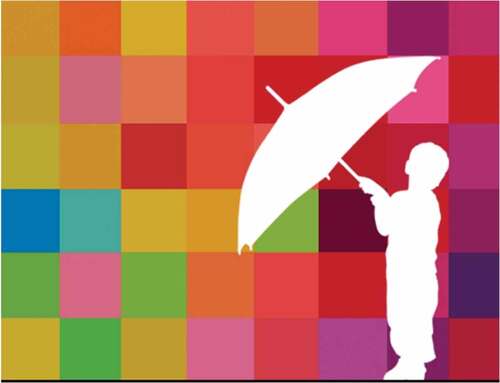
Autism inclusive urban environments design principles to support sensory and cognitive navigation.
For the attention of: Urban designers, landscape architects, regeneration practitioners, Autism Spectrum Condition (ASC) advocacy groups and all those involved with the design of the public realm.
The problem: A growing body of research proves that city green spaces provide positive physical and mental health benefits, however, access is not universal. Cities are planned for and designed by neurotypical people and can neglect neurodiverse and disability needs. For many people with Autism Spectrum Condition, cities can be difficult to navigate due to the cognitive and social challenges inherent in the urban built environment and therefore limits inclusive health benefits of urban environments.
What we did and why: This paper aims to identify the impacts of the built environment on the walkability of a city for those with Autism Spectrum Condition. Using film, photography, and recordings, two alternative journeys from a transport hub to a public park are analysed. A focus group consisting of parents of children with Autism Spectrum Condition aid the investigation by analysing the material gathered, before suggesting potential solutions to the identified challenges.
What our study adds: Suggestions to support inclusive access to meet Autism Spectrum Condition needs include:
Transition zones
Provision of dedicated quiet places in the city
Compartmentalisation of large spaces
Utilising technology before journeys alongside improving safety and signage.
Reflecting on the findings, this paper provides a number of urban design principles for the built environment which consider those with Autism Spectrum Condition that can support a shared urban built environment to be more inclusive for neurodiverse groups.
Implications for city policy and practice: Urban policy has recently started to engage with making places inclusive for those with cognitive impairments such as Autism Spectrum Condition. Often measures to make cities more ‘autism-friendly’ are limited to the sensory environment of individual buildings and staff training and neglect to consider broader Autism Spectrum Condition needs, therefore environments are hostile to navigate. This research offers suggestions for planning practice to create the city as a sensorium through inclusive design that helps meet Autism Spectrum Condition sensory needs.
Full research article: Autism spectrum condition and the built environment by Keith McAllister, Aine McBeth (@ainemcbeth) and Neil Galway (@neil_galway).
Unpacking the meaning, measurement, and health impacts of social connectedness in cities: A guide for research and policy
Groups of people enjoying outdoor music concert. Photo: Leah Kelley.
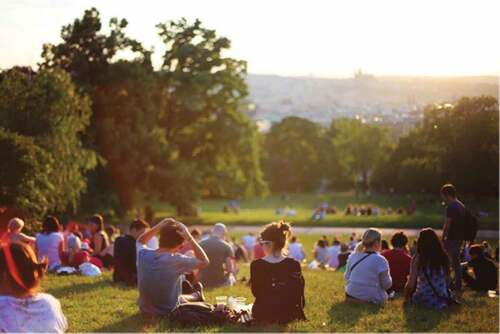
The meaning, measurement, causes and consequences of social connectedness in cities. A useful primer and pragmatic framework for healthy cities, urban futures and public health.
For the attention of: Urban planners, policy-makers and public health practitioners.
The problem: In response to concerns over social isolation and loneliness in cities – which intensified in the wake of COVID-19; promoting social connectedness came to the forefront of urban health agendas worldwide. Despite this policy attention, social connectedness is not consistently defined or measured in urban health research. Hence, inconsistencies create confusion for planners and policy makers looking for evidence-informed guidance on how to understand, monitor, and intervene on social connectedness.
What we did and why: Clarifying social connectedness for urban health research and policy is crucial to interpreting and advancing evidence on its role in the development of healthy cities.
With this purpose in mind, we set out to delineate the concept of social connectedness, including its meaning, measurement, and relationship to neighbourhoods and health. Our approach draws from the latest public health and urban planning research, along with a selection of older influential works.
What our study adds: This paper synthesizes a vast body of evidence on social connectedness into a useful conceptual primer for urban health researchers, planners, and policymakers. It presents:
a pragmatic framework of key definitions and metrics for operationalizing social connectedness,
an adapted model for exploring potential pathways between neighbourhood environments, social connectedness, and health,
a discussion on challenges and opportunities for studying social connectedness in cities, and implications for policy.
Implications for city policy and practice: With more consistent and comprehensive measurement in place, population health and urban planning research can advance evidence on the link between urban environments, social connectedness, and health; in turn helping cities to identify and scale effective interventions.
Our primer supports this work, while offering a vocabulary and set of metrics for social connectedness that city planners and policymakers can use to inform ongoing policy dialogue, action, and evaluation in their cities.
For further information:
Interventions, Research, and Action in Cities Team (INTERACT): A pan-Canadian collaboration of scientists, urban planners, public health practitioners and community partners uncovering the impact of urban changes on health and equity.
Full research article: Situating social connectedness in healthy cities: a conceptual primer for research and policy by Meridith Sones (@merisones), Caislin L. Firth, Daniel Fuller, Meg Holden, Yan Kestens and Meghan Winters.
Community wellbeing in the built environment: breaking down building performance assessments
A tripartite model of social practices. Inspired by Shove et al.’s tripartite SPT model (2012).

Community well-being is acknowledged as being ‘greater than the sum of its parts’. Our paper identifies current gaps in community well-being assessments and recommends participatory mixed methods.
For the attention of: Local housing policymakers, policymakers interested in measuring community well-being and developers of multi-unit residential buildings.
The problem: Community well-being in the built environment is ‘greater than the sum of its parts’. However, methods have not caught up to demonstrate this in terms of evidence-based approaches. In practice, evaluation methods and frameworks are reductive, measuring community well-being as an aggregate of factors of individual well-being. They operate as a kind of ‘pick and mix’ of dimensions and indicators. As such, they are ill-suited to reflect value in an appropriate way when used to inform planning policy and practice that seeks to improve community well-being.
What we did and why: We aligned the concept of community well-being with current building performance assessment methods. For our approach, we integrated a Social Practice Theory lens to understand the interaction between community factors and features of the built environment. Social Practice Theory being a psychological approach that seeks to determine the link between practice and context in ‘on the ground’ implementation.
What our study adds: In terms of analysis, we advocate participatory mixed methods to integrate community wellbeing theory into current assessment methods. Our example supports the development of a novel, evidence based tool for assessing community well-being in the built environment. We recommend improvements to community wellbeing assessment based on our own research, including participatory methods, local community engagement, and use of Photovoice.
Implications for city policy and practice: Our findings offer the following contributions to city policy and practice:
We review seven frameworks for community well-being in the built environment to identify gaps between theory and methodology
We recommend of participatory mixed-methods to address identified gaps
We illustrate how a Social Practice Theory lens allows us to conceive the concept of well-being as an emergent property for planning that is shared, and temporally and geographically bounded.
Full research article: Community wellbeing in the built environment: towards a relational building assessment by Norene Lach, Sarah McDonald, Sylvia Coleman, Marianne Touchie, John Robinson, Garrett Morgan, Blake Poland and Alstan Jakubiec.
Acknowledgments
The Cities & Health editorial board would like thank Lindsay McCunn and Hannah Arnett for spearheading this special issue. They have seen the project through from floating the idea to final publication, with diligence, inspiration, and aplomb.
We also acknowledge the support of our special issue partner, the Environmental Design Research Association.
We are grateful to all of the reviewers whose work supported the authors in improving and developing their papers. And, of course, we thank the authors who submitted papers to this issue—those that were accepted and those that, following review, we found that we were unable to publish. Finally, we wish to acknowledge you, the reader. We hope that you find material here to stimulate new thoughts (and hopefully actions) in the pursuit of better support for wellbeing through the way we plan, design, and govern our towns and cities.
A few words from our special issue partner:
The Environmental Design Research Association (EDRA)
We are honoured to have partnered with Cities & Health on this special issue titled: ‘Planning for people and health: Environmental psychology in the city’. EDRA’s purpose is to advance and disseminate research, teaching, and practice to improve an understanding of the relationships among people, their built environments, and natural eco-systems. The mission of EDRA is to provide a collaborative, multidisciplinary community to connect theory, research, teaching, and practice to recognize, create and advocate for environments that are responsive to diverse human needs. EDRA is committed to equity, inclusion, and respect for all persons. Through its annual conference, and internal knowledge networks, EDRA bridges theory, research, teaching, and practice each year by recognizing and creating more humane environments in collaboration with global stakeholders/communities. It also promotes cutting-edge research and practice that is essential to improve quality of life for all people. EDRA supports transcending disciplinary boundaries and industry sectors in collaborative pursuit of environments that are responsive to diverse human needs – and advocating for diverse voices in the pursuit of social justice. For more information about our organization, and how it aligned with the themes and goals of this special issue, please visit www.edra.org
